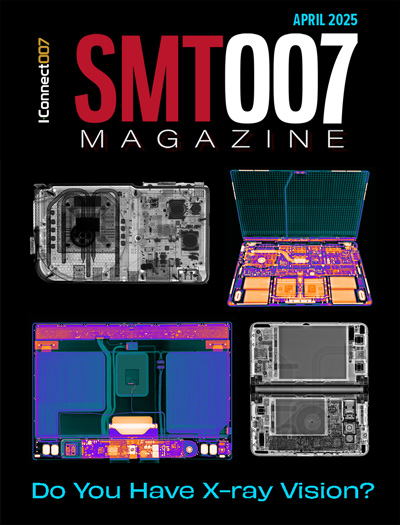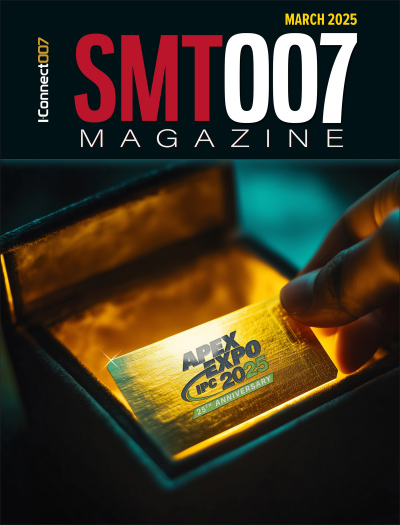-

- News
- Books
Featured Books
- smt007 Magazine
Latest Issues
Current Issue
Do You Have X-ray Vision?
Has X-ray’s time finally come in electronics manufacturing? Join us in this issue of SMT007 Magazine, where we answer this question and others to bring more efficiency to your bottom line.

IPC APEX EXPO 2025: A Preview
It’s that time again. If you’re going to Anaheim for IPC APEX EXPO 2025, we’ll see you there. In the meantime, consider this issue of SMT007 Magazine to be your golden ticket to planning the show.

Technical Resources
Key industry organizations–all with knowledge sharing as a part of their mission–share their technical repositories in this issue of SMT007 Magazine. Where can you find information critical to your work? Odds are, right here.
- Articles
- Columns
Search Console
- Links
- Media kit
||| MENU - smt007 Magazine
Liquid Encapsulation Application Considerations
December 31, 1969 |Estimated reading time: 6 minutes
Encapsulation typically begins with warming the liquid encapsulant, which is provided premixed, refrigerated (4°C), and packaged into syringes or cartridges. After the encapsulant has been allowed to stabilize at room temperature (25°C), it is ready for use.
By Robert Chu
The liquid encapsulant can be applied manually or using an X-Y computer-driven automated dispense system. One of the fundamental advantages of the liquid encapsulation process is its simplicity and flexibility. However, potential pitfalls exist for those unfamiliar with the material handling and application requirements of these materials.
The most common material handling and application errors include improper storage, warming, preheat or cure; inappropriate dispensing equipment; excessive "out-time"; and rework.
Material Handling
Liquid encapsulants generally require refrigerated storage at 4°C. Storage at temperatures above 4°C will shorten the material's shelf life. Exact shelf life reduction will vary, depending on the storage temperature and the specific encapsulant. Improper storage symptoms include apparent loss of pot life, higher dispense pressure requirements and abnormal material flow.
Liquid encapsulants must be warmed to room temperature before dispensing. The primary factors for determining the warming time are syringe size and storage temperature. The material should be allowed to warm at room temperature (25°C) to ensure that the encapsulant's internal temperature is uniform throughout the syringe or cartridge. Accelerated warming in an elevated temperature water bath or oven is not suggested.
Under-warming can have an insidious effect on an encapsulant's performance. Encapsulants should not be dispensed below the dew point (11°C) because it will cause excess moisture absorption. A lower onset of decomposition temperature is characteristic of materials exposed to moisture prior to cure (Figure 1). The more common symptoms of improper thaw are sluggish delivery during dispense, apparent loss of pot life (over-thaw), and white powdery or grainy encapsulant surface (under-thaw combined with high humidity).
 Figure 1. Encapsulants exposed to moisture prior to cure begin to decompose at lower temperatures.
Figure 1. Encapsulants exposed to moisture prior to cure begin to decompose at lower temperatures.
null
Substrate Preheat
Substrates commonly are preheated to minimize voids and to enhance the flow of the liquid encapsulant into fine-pitch wire bonded areas. Preheating a substrate also enhances surface wetout, which promotes improved adhesion.
Preheating the substrate can be optimized to increase or decrease the flow of the liquid encapsulant after it is dispensed. The substrate typically is preheated to 80°C for encapsulation applications. Increasing the substrate preheat temperature to 100°C allows the material to gel more quickly and can reduce the degree of spread. Decreasing the substrate preheat temperature may have the opposite effect.
The optimum substrate preheat temperature can be determined from an uncured differential scanning calorimetry (DSC) and a viscosity vs. temperature plot for any given product. As an illustration, Figures 2 and 3 show the optimum range between 80° and 110°C for this sample encapsulant.*
Improper substrate preheat temperatures manifest themselves as erratic or inconsistent material flow and dispense. Preheating the syringe is not an alternative because it may shorten the pot life of the encapsulant substantially or lead to dispensing inconsistencies due to filler settling.
 Figure 2. Differential Scanning Calorimetry (DSC) results.
Figure 2. Differential Scanning Calorimetry (DSC) results.
null
 Figure 3. A viscosity vs. temperature plot. Compared to Figure 2, this shows an optimum substrate preheat temperature of 80° to 110°C for a sample encapsulant.*
Figure 3. A viscosity vs. temperature plot. Compared to Figure 2, this shows an optimum substrate preheat temperature of 80° to 110°C for a sample encapsulant.*
null
Excessive Out-time
Exposing uncured encapsulant to air for more than one hour during staging periods increases the risk of moisture absorption. Generally, the longest out-time occurs while the parts are accumulating prior to batch oven curing.
Liquid encapsulant should be limited to one hour of exposure prior to cure. If possible, the material should be gelled following the encapsulant dispense process, because gelled material is much less susceptible to moisture absorption prior to cure completion.
Exposure of uncured liquid encapsulants has been related to degradation in pressure cooker test (PCT) performance (Figure 4). The symptoms of excessive out-time prior to cure are a white powder/grainy encapsulant surface, unusual surface appearance and poor solvent resistance.
 Figure 4. Uncured liquid encapsulants** absorb moisture and degrade when exposed to air for more than one hour.
Figure 4. Uncured liquid encapsulants** absorb moisture and degrade when exposed to air for more than one hour.
null
Improper Cure
Thorough cure of liquid encapsulants is essential to optimize the material's ultimate reliability. Although cure times and temperatures are recommended for each product, end users commonly redefine cure schedules due to temperature and time sensitivities.
Monitoring the T(g) development and exotherm presence by DSC analysis can determine the extent of cure. Step cures commonly are used to minimize thermal-related stress effects, cracking and substrate warping. Figures 5 and 6 illustrate the effect of gel time on T(g) development and the extent of cure as determined by DSC for a typical liquid encapsulant.* The figures indicate that a minimum of two hours at 125°C is required for the initial material to gel. Symptoms of improper cure are cracking or edge lift, poor solvent resistance, degradation of reliability performance (T-cycle, PCT, etc.), and substrate warping.

null
 Figures 5 and 6. A minimum cure of two hours at 125°C is required for this sample encapsulant* to gel.
Figures 5 and 6. A minimum cure of two hours at 125°C is required for this sample encapsulant* to gel.
null
Dispensing Considerations
Liquid encapsulants are inherently adaptable to various applications, although the actual dispense process may vary by application. Until recently, manual or automated time-pressure dispensing has been the preferred method of encapsulant application.
Difficulties in the time-pressure process can be caused by the selected dispensing parameters or the design of the syringe/piston configuration. The most commonly used syringe styles cause air voids in the encapsulant during the product fill process and may cause "sputtering" during product dispensing. A syringe designed for the filling process decreases the material sputtering effect during product dispensing.
The time-pressure dispense process may cause inconsistencies in the volume and rate of encapsulant applied, a problem often mistaken for inconsistent material flow or slumping. By weighing encapsulated parts and comparing them to a predetermined weight requirement, the end user may calibrate the dispenser.
For best results, the process should be designed to ensure that a reproducible amount of material is dispensed. The best way to consistently control the volume of material dispensed, regardless of minor variation in the material flow or viscosity, is to use a positive displacement valve. Most liquid encapsulants incorporate abrasive silica fillers. Positive displacement valves must be fitted with abrasion-resistant wetted parts.
Higher filler loadings, up to 80 percent by weight, are required to achieve low CTE levels. Under these conditions, filler properties begin to affect viscosity and encapsulant flow. Small, normally acceptable batch-to-batch variations in the filler may cause the encapsulant dispensing rate to vary too much for many applications, especially where tight flow control is required. Certain dispense valves are capable of controlling both the volume of material dispensed and the material dispense rate.
Rework
Due to one or more of the previously mentioned errors, an end user's parts may come out of the oven showing incomplete coverage, usually exhibited by exposed wire loops. "Rework," or re-encapsulation of the exposed areas is not recommended. Adhesion of a second coat to the original layer always will be suspect. The interface may be vulnerable to crack generation and provide a path for moisture. Rework can be performed prior to cure with no problems. The end user should inspect the parts after the encapsulant dispensing process and rework them immediately.
Cured liquid encapsulants are formulated to provide superior physical and chemical protection against solvents and acids. To remove an encapsulant for rework or failure analysis after cure, fuming nitric or sulfuric acid often is used. However, the risk of damaging the substrate and other areas does exist. A "nitric etcher" unit can be used for rework or decapsulation of the chip area for failure analysis. Solvents other than acids also may be used to dissolve various cured liquid encapsulants.
Conclusion
Liquid encapsulants increasingly are being used in high-end applications because of technology advancements that have delivered reliability levels typically associated with those of molding compounds. As the industry gains a better understanding of liquid encapsulant rheology as it relates to dispensing properties and equipment availability, the use of these materials becomes more acceptable.
*Hysol FP4401
**Hysol FP4402
Robert Chu, global products manager, electronics, Henkel Japan Ltd., may be contacted at Henkel Loctite Technology Center — Asia Pacific, 27-7 Shin Isogocho, Isogoku, Yokohama, Japan 235-0017; +81 45 758 1800; Fax +81 45 758 1839; E-mail: robert.chu@loctite.co.jp.


